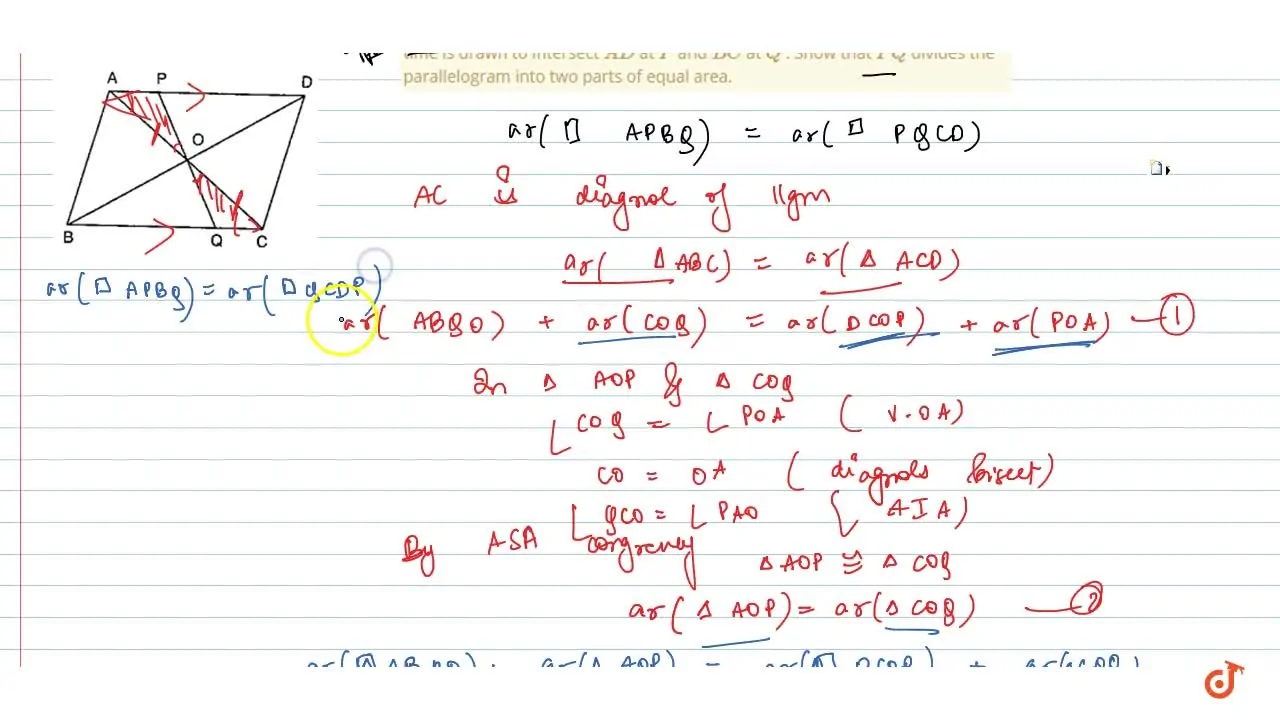The diagonals of a parallelogram ABCD intersect at a point O. Through O , a time is drawn to intersect AD at P and BC at Q . Show that PQ divides the parallelogram into two parts of equal area.
Given: The diagonals of a parallelogram ABCD intersect at a point O. Through O, a line is drawn to intersect AD at P and BC at Q.
To Prove: ar(PDCQ)=ar(PQBA)
Proof: AC is a diagonal of ∣∣gmABCD
∴ar(△ABC)=ar(△ACD)
=12ar(∣∣gmABCD) ....(i)
In △AOP and △COQ,
AO=CO [Diagonals of a parallelogram bisect each other]
∠AOP=∠COQ [Vertically opposite angles]
∠OAP=∠OCQ [ Alternate interior angles]
∴△AOP=△COQ
∴ar(△AOP)=ar(△COQ) [By ASA Congruency]
⇒ar(△AOP)+ar(OPDC)
=ar(△COQ)+ar(OPDC)
⇒12ar(∣∣gmABCD)=ar(PDCQ)
From equation (1):
⇒ar(PQBA)=ar(PDCQ)
⇒ar(PDCQ)=ar(PQBA)
Hence Proved.
Related Playlists
Similar Questions
The diagonals of a parallelogram ABCD intersect at a point O. Through O, a line is drawn to intersect AD at P and BC at Q. Show that PQ divides the parallelogram into two parts of equal area.
View SolutionThe diagonals of a parallelogram ABCD intersect at a point O. Through O , a time is drawn to intersect AD at P and BC at Q . Show that PQ divides the parallelogram into two parts of equal area.
View SolutionThe diagonals of a parallelogram ABCD intersect at a point O. Through O, a line a drawn to intersect AD at P and BC at Q. Show that PQ divides the parallelogram into two parts of equal area.
View SolutionThe diagonals of a parallelogram ABCD intersect at OA line through O intersects AB at XandDC at Y Prove that OX=OY
View SolutionThe diagonals of a parallelogram ABCD intersect at O. A line through O meets AB in X and CD in Y. Show that ar(AXYD)=12(ARgmABCD)
View SolutionABCD is a parallelogram. A circle through A, B is so drawn that it intersects AD at P and BC at Q. Prove that P, Q, C and D are concyclic.
View SolutionABCD is a parallelogram whose diagonals AC and BD intersect at O. A Line through O intersects AB at P and DC at Q. Prove that ar(△POA)=ar(△QOC).
View SolutionABCD is a parallelogram whose diagonals AC and BD intersect at O. A line through O intersects AB at P and DC at Q. Prove that ar (ΔPOA)= ar (ΔQOC).
View SolutionDiagonals of a parallelogram intersect each other at point Q. If AQ =5, BQ =12and AB =13, then show that ABCD is a rhombus.
View SolutionABCD is a parallelogram whose AC and BD intersect at O. A line through O intersects AB at P and DC at Q. Prove that ar ( POA)= ar ( QOC).
View Solution


